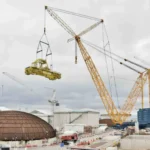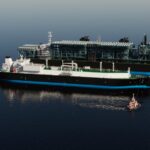Energy News Beat
The French nuclear giant EdF, the government owned company that manages the country’s vast fleet of nuclear power stations, has reportedly scrapped its plans to develop a new design for small nuclear reactors because of fears of soaring costs.
EdF, which is now fully government owned after facing potential bankruptcy due to delays and massive cost over-runs at its latest generation large scale nuclear plants, had reportedly been working on a new design for SMRs for the last four years.
The French investigative outlet L’Informé reported on Monday that EdF had scrapped its new internal SMR design – dubbed Nuward – because of engineering problems and cost overruns. It cited company sources as saying EdF would now partner with other companies to use “simpler” technologies in an attempt to avoid delays and budget overruns.
Reuters confirmed the development, citing an email from a company spokesman that confirmed the program had been abandoned after the basic design had been completed.
“The reorientation consists of developing a design built exclusively from proven technological bricks. It will offer better conditions for success by facilitating technical feasibility,” an EDF spokesperson told Reuters via email.
It’s the latest problem to hit SMR technology, which the federal Coalition wants to roll out in Australia – starting with reactors in South Australia and Western Australia – as part of its goal of keeping coal plants open, building more gas, stopping renewables and putting clean energy hopes on nuclear.
The federal Coalition says it can have the first SMR up and running by 2035, but no SMRs have been built in the western world, and none have even got a licence to be built.
The closest to reach that landmark, the US-based NuScale, abandoned its plans after massive cost overruns and push back from its customers, who refused to pay high prices.
The EdF plans appears to have run into similar problems. Its potential customers, the European energy companies Vattenfall, CEZ and Fortum, wanted guarantees that the SMRs would not have a levelised cost of energy of more than €100 a megawatt hour ($161/MWh) and EdF decided that that was not possible.
It is now not expected to produce its first SMR until the 2030s, at the earliest – even though France is desperate for new reactors to replace its ageing power plants. Because of the costs, it expects to significantly reduce the share of nuclear in its energy mix as it focuses more on large scale solar and offshore wind.
EdF has run into similar problems with its large scale technology. The Flammanville project in France was announced in 2004 with a budget of €3 billion and a deadline of 2012. It is still not in operation and its costs have soared at least four-fold to €13.2 billion.
The Hinkley C project in the UK has been an even bigger disaster. EdF had promised in 2007 that it would be “cooking Christmas turkeys” in England by 2017, at a cost of £9 billion, but is already delayed to 2031 with a spiralling cost of £48 billion when inflation is taken into account, or $A93 billion.
EdF announced another impairment charge of €12.9 billion ($A20.7 billion) from Hinkley earlier this year. It had to be bailed out by the government last year after suffering record losses in 2022 caused by outages at nearly half of its nuclear power plants due to maintenance at its reactors across France.
Tim Buckley, from Climate and Energy Finance, seized on the news and called on Opposition leader Peter Dutton and energy spokesman Ted O’Brien to provide more details of their nuclear plans beyond the one page press release they released last month.
“Come’on guys, how naive do you take the average Australian voter for?” Buckley wrote.
“In your alternate fact world, who do you think will pay for the permanent around 50% increase in Australian energy prices for consumers? Are you really intent on destroying the international competitiveness of Australian industry purely in the service of your fossil fuel funders?”
Numerous cost assessments, particularly by the CSIRO and the Australian Energy Market Operator, have put the cost of nuclear at more than double the cost of wind, solar and storage. But they also point out that first of their kind projects in Australia could cost double that amount, and SMR technology is likely to be even more expensive.
The Coalition has attacked those reports, and the reputation of the CSIRO and AEMO – in concert with a group of so-called “think tanks” and the Murdoch media – but the latest polling from Essential Media suggests that the public might not be buying it.
The poll found that votes believe renewables are the most desirable (59 per cent) and the best for the environment (55 per cent). Nuclear energy was regarded by more as the most expensive (38 per cent versus 35 per cent for renewables).
An overwhelming majority of people aged 18 to 54 thought Peter Dutton’s nuclear energy plan “is just an attempt to extend the life of gas and limit investment in large-scale renewables”, while a majority of those aged over 55 thought the nuclear plan is serious and should be part of the future energy mix, Essential Media’s Peter Lewis wrote.
The federal Coalition has argued that nuclear might be expensive to build, but will deliver cheaper power to consumers. It has not explained how, but it has said that its reactors would be government owned, suggesting that – like France and Ontario – the costs would be borne by taxpayers and the supply of power to customers would be heavily subsidised.
Take the Survey at https://survey.energynewsbeat.com/
Crude Oil, LNG, Jet Fuel price quote
ENB Top News
ENB
Energy Dashboard
ENB Podcast
ENB Substack
The post French nuclear giant scraps SMR plans due to soaring costs, will start over appeared first on Energy News Beat.








